Are You Earning Up to Your Potential?
Most personal trainers are undervaluing their time and skills. Our Personal trainer Revenue Calculator helps you find out what you should be making, and how to get there.
No guesswork. Just real numbers.
.jpg)
The fitness industry has experienced unprecedented growth, with millions of people turning to mobile apps for their health and wellness needs. For fitness coaches, trainers, gym owners, and fitness business owners, creating a custom fitness app presents an incredible opportunity to expand your reach and provide personalized experiences to your clients.
This comprehensive guide will walk you through every aspect of fitness app development, from initial planning to post-launch optimization. Whether you're looking to develop your first fitness application or enhance your existing digital presence, this resource covers everything you need to know about building successful workout and training apps.
Understanding the Fitness App Market
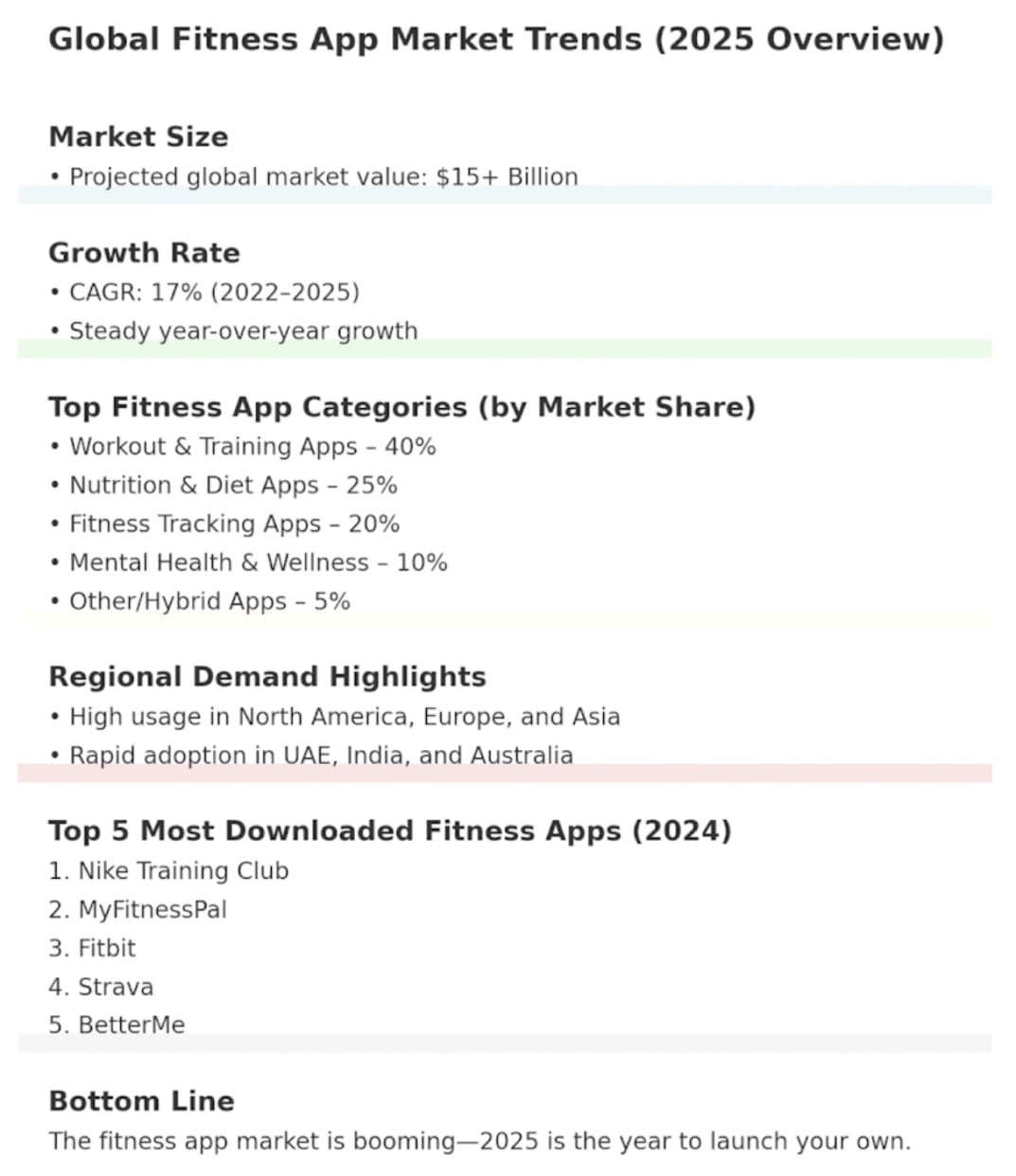
Current State of the Fitness App Market
The fitness app market has reached new heights, with billions of downloads across various app stores. Market research indicates that fitness mobile app development continues to grow at an exponential rate, driven by increasing health consciousness and the convenience of mobile technology.
The global fitness app industry generates significant revenue through various monetization models, including subscription services, in app purchases, and premium features. This growth trajectory makes fitness app development an attractive investment for fitness business owners.
Target Audience Analysis
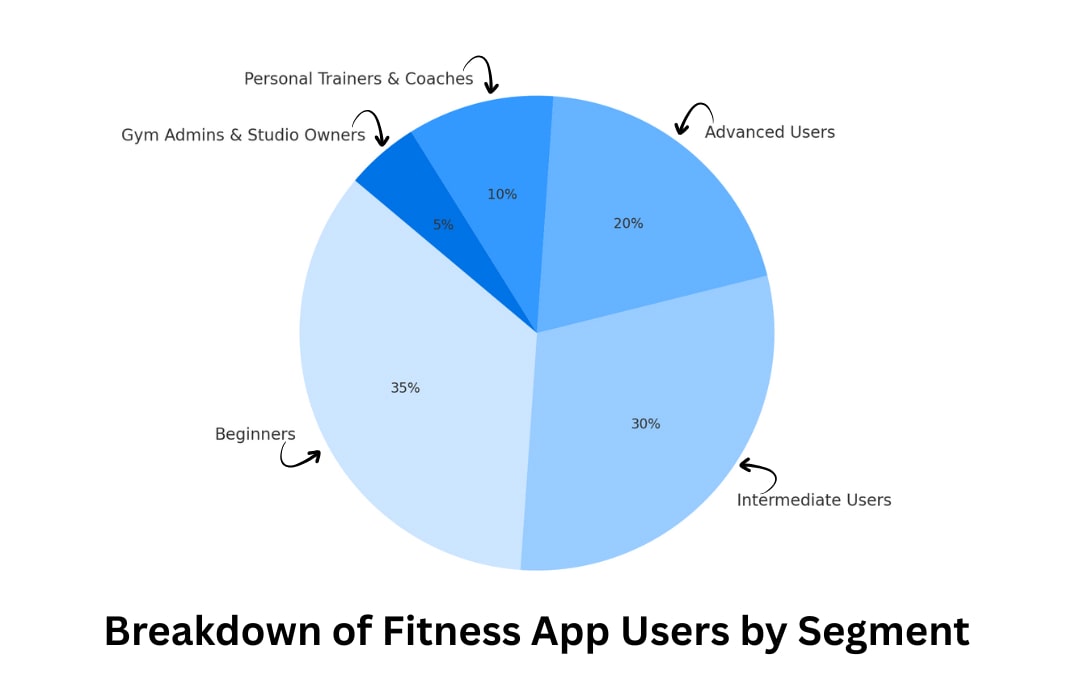
Understanding your target audience is crucial for successful fitness app development. Fitness enthusiasts range from beginners seeking guidance to advanced athletes looking for specialized training programs. Each segment has unique user expectations and requirements.
Fitness coaches and personal trainers represent a significant portion of the market, seeking apps that can help them manage clients, track user progress, and deliver personalized workout plans. Gym owners often require comprehensive solutions that integrate with their existing systems and provide member management capabilities.
Market Research Fundamentals
Conducting thorough market research is essential before starting your fitness app development journey. This research should examine existing leading fitness apps, identify gaps in the market, and understand user feedback patterns.
Analyzing competitors like Nike Training Club and other popular fitness applications provides valuable insights into successful features and user interface designs. This research helps inform your own fitness app idea and development process.
Types of Fitness Apps
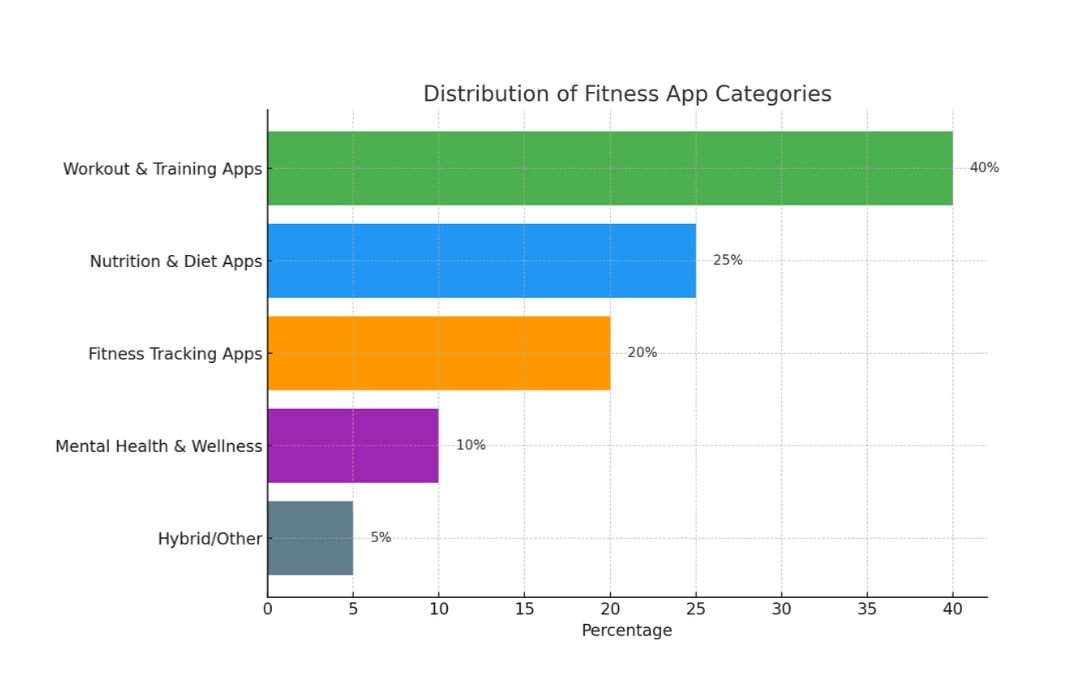
Workout and Training Apps
Workout apps form the backbone of the fitness application market. These apps provide users with structured exercise programs, video demonstrations, and progress tracking capabilities. Personal trainer apps fall into this category, offering one-on-one coaching experiences through mobile platforms.
Gym workout app development focuses on creating comprehensive exercise libraries with detailed instructions and proper form guidance. These apps often include features like rep counters, rest timers, and workout history tracking.
Nutrition App and Diet and Nutrition Apps
Nutrition apps complement workout apps by helping users manage their dietary intake and achieve their fitness goals. These apps typically include calorie counting, meal planning, and nutritional analysis features.
Diet and nutrition apps have become increasingly sophisticated, offering personalized meal recommendations based on user preferences, dietary restrictions, and fitness objectives. Coaches often rely on dedicated nutrition coaching software to create meal plans that sync seamlessly with training programs.
Health and Fitness App Tracking
Fitness tracking apps focus on monitoring various health metrics, from daily step counts to heart rate variability. These applications often integrate with wearable devices to provide comprehensive health data analysis.
Sleep tracking and mental health monitoring have become important components of modern fitness trackers. These features address the growing awareness of the connection between physical and mental health.
Mental Health and Wellness Apps
Mental health apps address the psychological aspects of fitness and wellness. These applications provide meditation guidance, stress management techniques, and mood tracking capabilities.
The integration of mental health features into fitness applications reflects the industry's evolution toward holistic wellness solutions. Users increasingly expect such apps that support both physical fitness and mental well-being.
💪 Got an idea for a brand? Let's bring it to life.
Launch your own fitness app with FitBudd in minutes!

💪 Got your brand name? Let’s bring it to life.
Launch your own fitness app with FitBudd in minutes!


88% trainers worldwide gave us 5 stars
Transform your fitness business with the power of your branded app on iOS and Android.
Try for FREEEssential Fitness App Features
Core Functionality Requirements
Every successful fitness app must include certain fundamental features that users expect. These core functionalities form the foundation of your fitness application and determine its usability and effectiveness.
User registration and profile management allow individuals to create personalized accounts and track their fitness progress over time. These features should be intuitive and secure, protecting user data while providing easy access to personal information.
Progress Tracking Capabilities
Progress tracking stands as one of the most crucial fitness app features. Users want to monitor their improvements, set goals, and visualize their fitness journey through charts, graphs, and achievement badges.
Comprehensive progress tracking should include workout history, performance metrics, body measurements, and goal achievement records. This data helps users stay motivated and allows fitness professionals to provide better guidance.
Workout Planning and Scheduling
Effective workout planning tools enable users to create, modify, and schedule their exercise routines. These features should accommodate various fitness levels and preferences while providing flexibility for different training styles.
Personalized workout plans based on user goals, fitness level, and available equipment increase user engagement and satisfaction. The ability to customize and adjust these plans ensures long-term app usage.
Social Features and Community Building
Social features foster community engagement and provide motivation through peer support. These elements can include workout sharing, progress comparisons, challenges, and group activities.
Creating a sense of community within your fitness app encourages user retention and builds a loyal user base. Social features should be optional, allowing users to choose their level of interaction.
Integration with Wearable Devices
Modern fitness apps must integrate seamlessly with popular wearable devices and fitness trackers. This integration provides users with comprehensive health data and enhances the overall user experience.
Wearable devices integration allows for real-time monitoring of vital signs, activity levels, and sleep patterns. This data can be used to provide personalized recommendations and adjust workout plans accordingly.
Planning Your Fitness App Development
Defining Your App's Purpose and Goals
Before beginning the fitness app development process, clearly define your app's primary purpose and objectives. Are you creating a personal trainer app, a gym management solution, or a comprehensive health platform?
Your app's purpose should align with your business goals and target audience needs. This clarity guides all subsequent development process decisions and helps prioritize features during the fitness app development.
Identifying Your Unique Value Proposition
Your fitness app idea must offer something unique to stand out in the competitive fitness app market. This could be specialized workout programs, innovative tracking methods, or superior user interface design.
Consider what makes your approach to fitness different from existing fitness solutions. Your unique value proposition should be clearly communicated throughout your app's design and marketing materials.
Setting Development Timeline and Budget
Fitness app development projects require careful planning and resource allocation. Establish realistic timelines that account for design, development, testing, and launch phases.
Budget considerations should include development costs, ongoing maintenance, marketing expenses, and potential revenue sharing with app stores. Factor in additional costs for specialized features or third-party integrations.
Choosing the Right Development Approach
Decide whether to build native apps for iOS and Android separately or use cross-platform development tools. Each approach has advantages and trade-offs in terms of performance, cost, and development time.
Consider your target audience's platform preferences and usage patterns. Some fitness apps perform better on specific platforms due to user demographics or device capabilities.
Market Research and Competition Analysis
Analyzing Successful Fitness Apps
Study leading fitness apps to understand what makes them successful. Examine their features, user interface design, monetization strategies, and user feedback patterns.
Nike Training Club, for example, combines high-quality workout videos with personalized training programs and social features. Understanding these successful elements can inform your own fitness app development strategy.
Identifying Market Gaps and Opportunities
Look for underserved segments in the fitness app market. These could be specific demographics, fitness disciplines, or feature combinations that existing apps don't address adequately.
Market gaps often exist in specialized areas like rehabilitation exercises, senior fitness programs, or specific sports training. Targeting these niches can provide competitive advantages.
User Feedback Analysis
Examine user reviews and ratings for existing fitness applications. Pay attention to common complaints, requested features, and praise for specific functionalities.
User feedback provides valuable insights into what works and what doesn't in current fitness apps. This information helps you avoid common pitfalls and incorporate desired features.
Competitive Positioning Strategy
Develop a clear positioning strategy that differentiates your fitness app from competitors. This strategy should address how your app solves problems that others don't or does so more effectively.
Your positioning should be reflected in your app's features, design, marketing messages, and user experience. Consistency across all touchpoints reinforces your competitive advantage.
Technical Requirements and Tech Stack
Choosing the Right Technology Stack
Selecting the appropriate tech stack is crucial for successful fitness app development. Your choice affects performance, scalability, maintenance costs, and development speed.
Consider factors like your development team's expertise, project requirements, scalability needs, and budget constraints when choosing technologies. Popular choices include React Native, Flutter, Swift, and Kotlin.
Database Design and Management
Fitness apps generate significant amounts of user data, requiring robust database design and management strategies. Consider data types, storage requirements, and access patterns when designing your database.
Health data requires special attention to privacy and security regulations. Ensure your database design complies with relevant healthcare data protection standards.
API Development and Integration
Many fitness apps rely on third-party APIs for features like nutrition databases, exercise libraries, or wearable device integration. Plan your API strategy early in the development process.
Custom API development may be necessary for unique features or specific integrations. Ensure your APIs are secure, well-documented, and scalable.' instead of 'Ensure your APIs are well-documented, secure, and scalable.
Cloud Infrastructure and Hosting
Cloud hosting provides scalability and reliability for fitness applications. Choose cloud providers that offer appropriate services for your app's requirements and compliance needs.
Consider factors like data location, backup strategies, disaster recovery, and performance optimization when selecting cloud infrastructure.
Skip the Technical Complexity with FitBudd
If you’d rather focus on training clients and growing your fitness business than managing tech stacks, infrastructure, and development teams, FitBudd offers a simpler path.
It’s a fully built platform that gives you your own branded fitness app with core features like progress tracking, workout plans, nutrition tools, in-app purchases, and Mindbody integration—without having to worry about the underlying tech stack.
User Experience and Interface Design
Design Principles for Fitness Apps
Effective fitness app design prioritizes usability, motivation, and accessibility. The interface should be intuitive enough for users to navigate during workouts while providing comprehensive functionality.
Visual hierarchy, clear navigation, and consistent design elements help users focus on their fitness goals rather than struggling with the app interface. Color schemes and typography should support readability in various lighting conditions.
Creating Intuitive Navigation
Navigation design significantly impacts user experience and retention rates. Users should be able to access core features quickly and understand how to move between different sections of the app.
Consider the context of use when designing navigation. Users often interact with fitness apps during workouts, requiring larger touch targets and simplified navigation paths.
Accessibility Considerations
Designing for accessibility ensures your fitness app can be used by people with various abilities and disabilities. This includes visual, auditory, and motor accessibility considerations.
Accessibility features not only serve users with disabilities but also often improve the experience for all users. Voice commands, for example, can be helpful during hands-free workout sessions.
Visual Design and Branding
Your fitness app's visual design should reflect your brand identity while appealing to your target audience. Consistent branding across all app elements builds trust and recognition.
Consider how your visual design motivates users and supports their fitness journey. Bright, energetic colors might work well for high-intensity workout apps, while calming tones might suit meditation or wellness apps.
Development Process and Methodologies
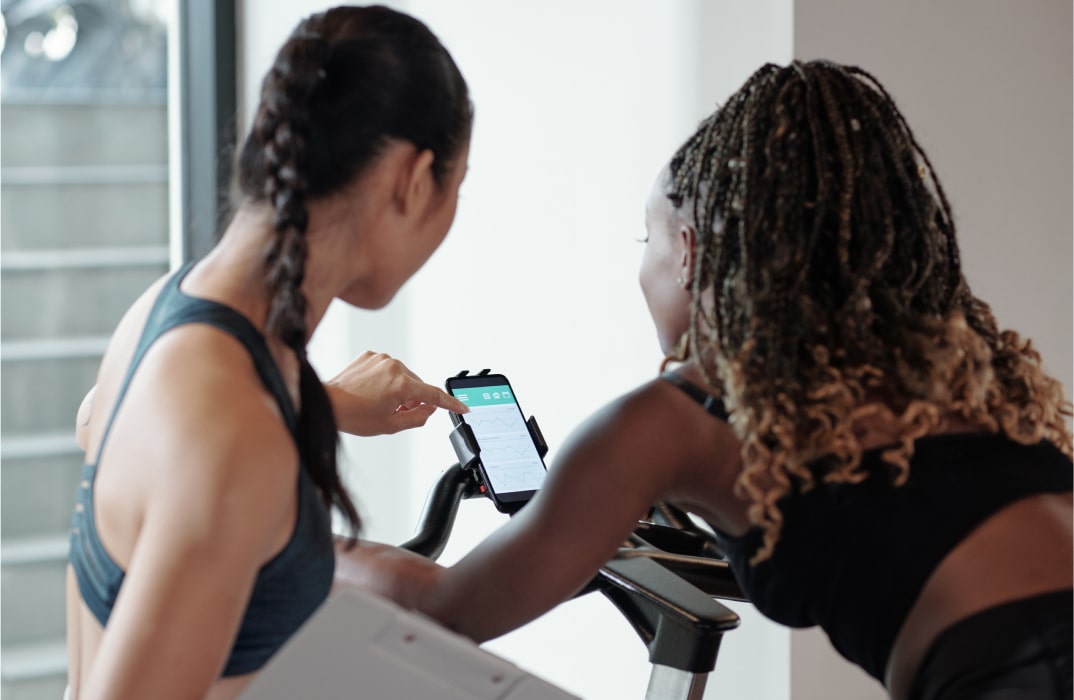
Agile Development Approach
Agile methodologies work well for fitness app development, allowing for iterative improvements and regular user feedback integration. This approach helps ensure the final product meets user needs and expectations.
Sprint-based development cycles enable regular testing and refinement of features. This approach is particularly valuable for fitness apps, where user experience is critical to success.
Prototype Development and Testing
Creating prototypes early in the development process helps identify potential issues and validate design decisions. Interactive prototypes allow stakeholders to experience the app's functionality before full development.
User testing with prototypes provides valuable feedback that can be incorporated before significant development investment. This approach reduces the risk of building features that don't meet user needs.
Quality Assurance and Testing
Comprehensive testing is essential for fitness apps, which users rely on for health and safety guidance. Testing should cover functionality, performance, security, and usability aspects.
Device testing is particularly important for fitness apps, as they must work reliably across various smartphones, tablets, and wearable devices. Performance testing ensures the app works smoothly during intensive workout sessions.
Equally vital is cross browser testing, which ensures that your fitness app’s web version performs consistently across browsers like Chrome, Safari, Edge, and Firefox.
Version Control and Code Management
Proper version control practices ensure smooth collaboration among development team members and provide rollback capabilities if issues arise.
Code management strategies should include regular backups, branching strategies for different features, and clear documentation for maintenance and updates.
Key Features for Different User Types
Personal Trainer Apps Features
Personal trainer apps require specialized features that support professional coaching relationships. These include client management systems, progress tracking tools, and communication features.
Scheduling and appointment management help trainers organize their client sessions and track availability. Payment processing integration can streamline billing and reduce administrative overhead.
Gym Management Integration
GGym owners need features that integrate with their existing systems and provide member management capabilities. This is where gym CRM software becomes invaluable—helping to streamline memberships, payments, and engagement.
Equipment management features help gym owners track maintenance schedules and usage patterns. Integration with access control systems can provide seamless user experience and member check-in experiences.
Client Progress Tracking
Comprehensive progress tracking tools allow fitness professionals to track user progress and adjust programs accordingly. This includes workout completion rates, performance metrics, and goal achievement tracking.
Visual progress reports help clients understand their improvements and stay motivated. These reports should be easy to generate and share with clients or healthcare providers.
Communication and Support Features
Effective communication tools enable fitness professionals to provide ongoing support and guidance to their clients. This includes messaging systems, video calling capabilities, and group communication features.
Support features should be easily accessible and provide multiple contact methods. FAQ sections and help documentation can reduce support requests and improve user satisfaction.
Advanced Features and Innovations
Artificial Intelligence and Machine Learning
AI and machine learning technologies can enhance fitness apps by providing personalized recommendations, analyzing user behavior patterns, and predicting user needs. Some platforms even integrate an AI workout generator to instantly create adaptive training plans based on client data.
Machine learning algorithms can analyze workout data to suggest optimal rest periods, exercise progressions, and injury prevention strategies. These features provide value that goes beyond basic fitness tracking capabilities.
Augmented Reality Integration
AR technology can enhance workout experiences by providing virtual trainers, exercise form correction, and interactive workout environments. This technology is particularly valuable for home workout app applications.
AR features can make workouts more engaging and provide real-time feedback on exercise form. This technology can help bridge the gap between in-person and remote training experiences.
Gamification Elements
Gamification features like achievement badges, leaderboards, and challenges can increase user engagement and motivation. These elements should be carefully designed to support long-term fitness goals.
Point systems, level progressions, and social competitions can make fitness activities more enjoyable and encourage consistent app usage. However, gamification should enhance rather than replace intrinsic motivation.
Voice Command Integration
Voice commands allow hands-free interaction with fitness apps, which is particularly valuable during workouts. This feature can include workout control, exercise logging, and progress updates.
Voice integration should be designed to work effectively in noisy gym environments and provide clear feedback to users. Natural language processing can make voice commands more intuitive and user-friendly.
Data Security and Privacy
HIPAA Compliance Considerations
Health and fitness apps that handle personal health information may need to comply with HIPAA regulations. Understanding these requirements is crucial for apps that store sensitive health data.
HIPAA compliance involves implementing appropriate security measures, obtaining necessary user consents, and establishing proper data handling procedures. Consult with legal experts to ensure compliance.
User Data Protection
Protecting user data goes beyond regulatory compliance and builds trust with your app users. Implement strong encryption, secure authentication, and regular security audits.
Data protection strategies should include secure data transmission, encrypted storage, and limited access controls. Users should have control over their data and understand how it's being used.
Privacy Policy Development
Clear privacy policies help users understand how their data is collected, used, and protected. These policies should be written in plain language and easily accessible within the app.
Privacy policies should be regularly updated to reflect changes in data handling practices or regulatory requirements. Users should be notified of significant policy changes.
Secure Data Storage Solutions
Implementing secure data storage solutions protects user information from unauthorized access and data breaches. This includes both local device storage and cloud-based storage systems.
Backup and recovery procedures ensure data availability while maintaining security. Regular security assessments help identify and address potential vulnerabilities.
Integration with Health Platforms

Apple Health and Google Fit Integration
Integration with major health platforms like Apple Health and Google Fit provides users with centralized health data management. This integration enhances the value of your fitness app by connecting with users' broader health ecosystems.
These integrations allow users to share data across multiple health and fitness apps, providing a more comprehensive view of their wellness journey. Proper integration requires understanding platform-specific APIs and data formats.
Third-Party Fitness Tracker Integration
Supporting popular fitness trackers and wearable devices expands your app's functionality and appeal. This integration provides users with more comprehensive activity tracking and eliminates the need for manual data entry.
Integration with devices like Fitbit, Garmin, and Apple Watch requires understanding each platform's API and data synchronization requirements. Reliable integration enhances user experience and app value.
Electronic Health Record Connectivity
For professional fitness applications, integration with electronic health records can provide valuable context for training programs and progress tracking. This integration requires careful attention to privacy and security requirements.
EHR integration can help fitness professionals understand client health conditions and develop appropriate exercise programs. This feature is particularly valuable for rehabilitation and specialized fitness applications.
Telemedicine Platform Integration
Integration with telemedicine platforms allows fitness professionals to provide comprehensive health and fitness services. This integration can include video consultations, health assessments, and treatment plan coordination.
Telemedicine integration requires understanding healthcare regulations and implementing appropriate security measures. This feature can differentiate your app in the competitive fitness app market.
Monetization Strategies
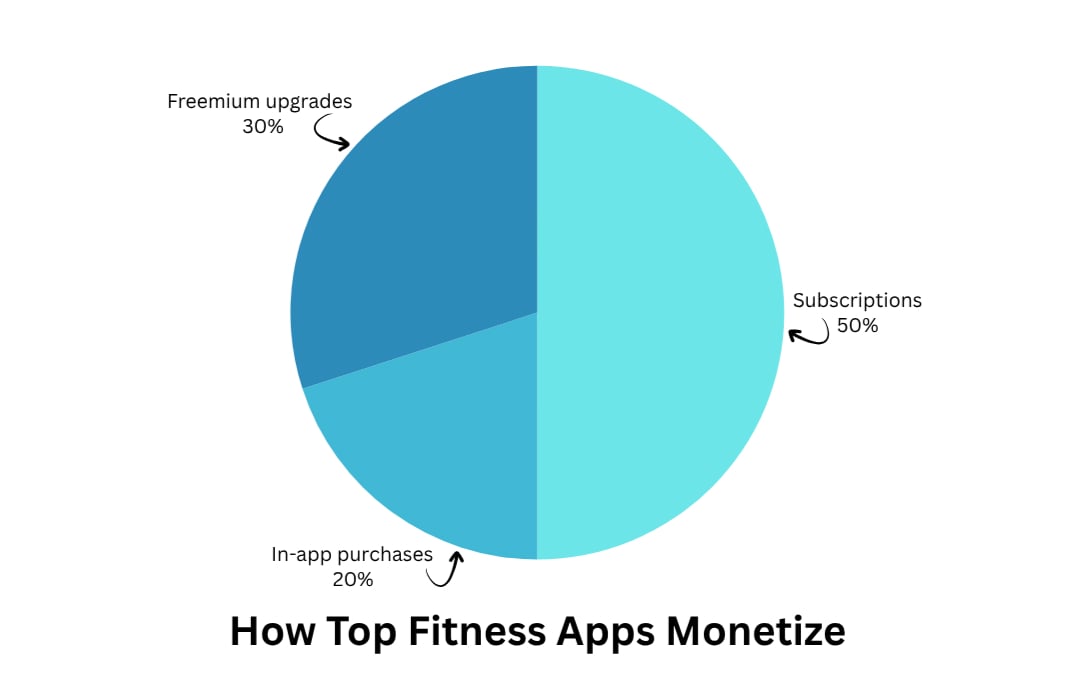
Subscription Models
Subscription-based monetization provides predictable revenue and encourages long-term user engagement. Different subscription tiers can offer varying levels of features and content.
Subscription models work well for fitness apps that provide ongoing value through new content, personalized coaching, or premium features. Pricing should reflect the value provided and remain competitive with similar apps.
In App Purchases Options
In app purchases allow users to access additional features, content, or services on a per-transaction basis. This model provides flexibility for users who prefer not to commit to subscriptions.
Popular in app purchase options include workout plans, nutrition guides, personalized coaching sessions, and premium content. These purchases should provide clear value to users.
Freemium vs Premium Models
Freemium models offer basic functionality for free while charging for advanced features. This approach can attract users who might not otherwise download a paid app.
Premium models charge upfront for app access but provide full functionality immediately. The choice between these models depends on your target audience and competitive positioning.
Corporate and Enterprise Solutions
Corporate wellness programs represent a significant market opportunity for fitness apps. These solutions often include employee health tracking, company-wide challenges, and wellness program management.
Enterprise solutions typically command higher prices and provide more stable revenue streams. Features might include administrative dashboards, reporting capabilities, and integration with corporate health systems.
Cost of Launching a Fitness App in 2025
Launching a fitness app involves multiple stages—from planning and design to development, testing, and marketing. The total cost can vary significantly depending on complexity, features, and the development approach. Here's a comprehensive cost breakdown based on industry averages:
Building a fitness app from scratch can be a major investment, often ranging from $80,000 to $170,000 depending on features, integrations, and development scope.
For fitness professionals looking for a simpler, more cost-effective approach, FitBudd offers a ready-to-use platform that includes essential tools like progress tracking, personalized workout plans, nutrition, class bookings, and more, starting at just $79/month.
👉 View FitBudd pricing
Testing and Quality Assurance
Beta Testing Programs
Beta testing programs allow real users to test your fitness app before the official launch. This testing provides valuable feedback on usability, features, and performance.
Beta testing should include diverse user groups representing your target audience. Feedback from beta testers can identify issues that internal testing might miss.
Performance Testing
Performance testing ensures your fitness app works reliably under various conditions, including high user loads and intensive feature usage. This testing is particularly important for apps that handle real-time data.
Performance testing should cover app responsiveness, battery usage, network connectivity, and resource management. Poor performance can lead to user frustration and app abandonment.
Security Testing
Security testing identifies vulnerabilities that could compromise user data or app functionality. This testing should be conducted by qualified security professionals.
Security testing should include penetration testing, vulnerability assessments, and code reviews. Regular security testing helps maintain user trust and regulatory compliance.
User Acceptance Testing
User acceptance testing validates that your fitness app meets user needs and expectations. This testing should be conducted with representatives from your target audience.
User acceptance testing focuses on real-world usage scenarios and user workflows. This testing helps ensure that your app will be successful in the market.
Launch Strategy and App Store Optimization
Pre-Launch Preparation
Pre-launch preparation sets the foundation for a successful app launch. This includes finalizing app store listings, preparing marketing materials, and establishing support systems.
Pre-launch activities should also include final testing, bug fixes, and performance optimization. A well-prepared launch creates positive first impressions and encourages user adoption.
App Store Submission Process
The app store submission process requires careful attention to guidelines and requirements. Both Google Play Store and the Apple App Store have specific requirements for health and fitness apps.
App store submissions should include compelling descriptions, high-quality screenshots, and appropriate keywords. Proper categorization helps users discover your app in relevant searches.
Marketing and User Acquisition
Marketing strategies should target your specific audience through appropriate channels. Fitness professionals might be reached through industry publications, while general users might be targeted through social media.
User acquisition strategies should focus on sustainable growth rather than short-term downloads. Building a loyal user base requires ongoing engagement and value delivery.
Launch Metrics and KPIs
Establishing key performance indicators helps measure launch success and identify areas for improvement. Important metrics include download rates, user engagement, and retention rates.
Launch metrics should be monitored closely during the first few weeks after launch. This data helps identify issues quickly and optimize app performance.
Post-Launch Support and Maintenance
User Support Systems
Effective user support systems help users resolve issues quickly and maintain positive app experiences. Support options should include multiple contact methods and comprehensive help documentation.
Support systems should be scalable and provide consistent experiences across different channels. Training support staff on app features and common issues ensures quality assistance.
Bug Fixes and Updates
Regular bug fixes and updates maintain app performance and user satisfaction. Update schedules should balance new features with stability improvements.
Update communication should clearly explain changes and improvements. Users appreciate transparency about bug fixes and new features.
Feature Enhancement Based on Feedback
User feedback provides valuable insights for feature enhancements and new functionality. Feedback collection should be systematic and actionable.
Feature enhancement decisions should be based on user needs, technical feasibility, and business objectives. Prioritizing enhancements helps maximize development impact.
Performance Monitoring
Ongoing performance monitoring identifies issues before they impact users significantly. Monitoring should include app performance, server performance, and user behavior analytics.
Performance monitoring tools should provide real-time alerts and detailed analytics. This data helps maintain optimal app performance and user experience.
Emerging Trends in Fitness App Development
Virtual Reality Fitness Experiences
Virtual reality technology is beginning to impact fitness app development by providing immersive workout experiences. VR fitness apps can simulate various environments and make workouts more engaging.
VR fitness experiences require specialized hardware and development expertise. However, they can provide unique value propositions that differentiate apps in the competitive market.
Blockchain Technology Applications
Blockchain technology can enhance fitness apps through secure data sharing, reward systems, and decentralized health records. These applications are still emerging but show promise for future development.
Blockchain applications in fitness apps might include secure health data sharing, cryptocurrency-based rewards, and decentralized fitness challenges. Implementation requires understanding blockchain technology and its limitations.
IoT Device Integration
Internet of Things devices can provide additional data sources for fitness apps. Smart scales, heart rate monitors, and environmental sensors can enhance app functionality.
IoT integration requires understanding various device protocols and data formats. Reliable integration with diverse devices can significantly enhance app value.
Personalized AI Coaching
Artificial intelligence can provide personalized coaching experiences that adapt to user preferences, performance, and goals. AI coaching can provide value that scales beyond human trainer availability.
AI coaching systems require significant training data and sophisticated algorithms. However, they can provide personalized experiences that improve user outcomes and engagement.
Choosing the Right Fitness App Development Approach: In-House, Outsourcing, or FitBudd
When considering fitness app development, one of the first decisions you’ll face is how to bring your app idea to life. The main options are building in-house, outsourcing to a fitness app development company, or using a dedicated fitness app development service like FitBudd.
In-House Development
In-house app development gives you complete control over every stage of the project. If you already have a team experienced in fitness mobile app development, backend systems, design, and QA, this can be an effective path.
You’ll be able to tailor your health and fitness app exactly to your brand's vision and manage the fitness app development process firsthand. However, the costs can be high, and timelines may extend significantly. Recruiting and managing fitness app developers, designers, and testers, along with coordinating deployment, security, and maintenance, requires significant time, money, and technical oversight.
Outsourced Development
Outsourcing your fitness app development project to an external agency or freelance team can reduce overhead and accelerate the development cycle. A professional fitness app development company typically brings a team of experts who can handle everything from UI/UX design and feature development to testing and post-launch support.
This option allows you to access experienced fitness app developers without building an internal team. However, outsourcing comes with its own set of challenges, including communication gaps, limited flexibility, and dependency on third-party timelines. You’ll still need to manage feedback loops, user expectations, and project milestones to ensure the outcome matches your business goals.
FitBudd: A Smarter Alternative to Traditional App Development
For fitness professionals who want to bypass the complexity of traditional development while still launching a high-quality, branded fitness app, FitBudd offers a purpose-built solution.
FitBudd is a dedicated fitness app development service designed specifically for fitness coaches, personal trainers, and gym owners. It gives you everything you need to launch your own custom workout app—without hiring developers or managing code.
With FitBudd, you get:
- A fully branded health and fitness app with your logo, colors, and identity
- Tools to build and deliver personalized workout plans
- Robust progress tracking to help you and your clients measure results
- Class booking, video calls, and in-app purchases built in
- Seamless integration with Mindbody for scheduling, payments, and client management
- A platform optimized for growth, engagement, and retention
Whether you’re starting your fitness app development journey or scaling an existing business, FitBudd gives you everything needed to compete with the leading workout and training apps—all without managing your own development team.
Scaling and Growth Strategies
User Acquisition and Retention
Sustainable growth requires both effective user acquisition and strong retention strategies. Acquisition efforts should focus on users who are likely to become long-term app users.
Retention strategies should focus on providing ongoing value and maintaining user engagement. Features like push notifications, personalized content, and social interactions can improve retention rates.
Geographic Expansion
Geographic expansion can significantly increase your app's market potential. However, expansion requires understanding local regulations, cultural preferences, and competition.
Expansion strategies should consider localization requirements, marketing approaches, and technical considerations. Successful expansion requires careful planning and execution.
Feature Expansion and Diversification
Adding new features and services can increase user engagement and revenue opportunities. Feature expansion should be based on user needs and market opportunities.
Diversification strategies might include adding nutrition tracking, mental health features, or corporate wellness solutions. New features should align with your app's core value proposition.
Partnership and Integration Opportunities
Strategic partnerships can provide access to new markets, technologies, and resources. Partnerships might include fitness equipment manufacturers, health organizations, or other app developers.
Integration opportunities with existing platforms and services can enhance your app's value and reach. Partnerships should be mutually beneficial and aligned with your growth objectives.
Measuring Success and Analytics
Key Performance Indicators
Establishing relevant KPIs helps measure your fitness app's success and identify improvement opportunities. Important metrics include user engagement, retention rates, and revenue generation.
KPI tracking should be consistent and actionable. Regular analysis of these metrics helps guide development decisions and business strategy.
User Behavior Analytics
Understanding user behavior provides insights into how people use your fitness app and where improvements might be needed. Analytics should track user journeys, feature usage, and engagement patterns.
User behavior analytics can identify popular features, common pain points, and opportunities for enhancement. This data helps prioritize development efforts and improve user experience.
Revenue Tracking and Optimization
Revenue tracking helps understand the financial performance of your fitness app and identify optimization opportunities. This includes subscription revenue, in app purchases, and other revenue streams.
Revenue optimization might involve pricing adjustments, feature enhancements, or new monetization strategies. Regular analysis helps maximize revenue potential.
User Feedback Integration
Systematic user feedback collection and analysis provide valuable insights for app improvement. Feedback should be collected through multiple channels and analyzed regularly.
Feedback integration should be systematic and actionable. User suggestions can provide valuable direction for feature development and user experience improvements.
Future-Proofing Your Fitness App
Technology Evolution Planning
The fitness app industry continues to evolve rapidly, with new technologies and user expectations emerging regularly. Planning for technology evolution helps ensure your app remains competitive.
Technology planning should consider emerging trends, platform updates, and changing user preferences. Flexible architecture and regular updates help adapt to changing requirements.
Regulatory Compliance Updates
Healthcare and fitness app regulations continue to evolve, requiring ongoing attention to compliance requirements. Staying informed about regulatory changes helps avoid compliance issues.
Compliance updates should be incorporated into regular app updates and maintenance cycles. Working with legal experts helps ensure ongoing compliance.
Market Adaptation Strategies
Market conditions and user preferences change over time, requiring adaptation strategies to maintain competitiveness. Market monitoring helps identify trends and opportunities.
Adaptation strategies should be based on market research, user feedback, and competitive analysis. Flexibility in approach helps respond to changing market conditions.
Continuous Innovation
Continuous innovation helps maintain user interest and competitive advantage. Innovation should be balanced with stability and user experience considerations.
Innovation planning should consider user needs, technical possibilities, and business objectives. Regular innovation keeps your app fresh and engaging for users.
Conclusion
Successful fitness app development requires strategic planning, quality execution, and ongoing user focus. From market research to post-launch optimization, every stage plays a role in building an app that delivers real value.
Whether you're a fitness coach or a gym owner, working with the right fitness app development company or exploring streamlined fitness application development services can help you bring your idea to life faster, without compromising on quality.
Whether you're a fitness coach or a gym owner, working with the right fitness app development company or exploring streamlined fitness application development services can help you bring your idea to life faster, without compromising on quality.
The fitness industry is evolving rapidly. Staying aligned with user needs, emerging trends, and proven app development practices will position your fitness application for long-term success.
By applying the insights shared in this guide, you're well on your way to launching a fitness app that drives engagement, supports your business goals, and stands out in a competitive digital space.
Frequently Asked Questions
The revenue potential for a fitness app varies widely based on features, monetization model, and user base. On average, successful health and fitness apps can generate anywhere from $10,000 to over $500,000 per month. Subscription-based workout apps typically earn more consistent income, especially when they offer exclusive training content, progress tracking, and personalized plans. According to industry insights from top fitness app developers, the global fitness app market continues to grow year-over-year, making it an attractive space for entrepreneurs. When you invest in professional fitness app development services, you position your brand for scalable revenue by tapping into in-app purchases, premium content, and affiliate partnerships. A well-executed fitness mobile app development strategy that includes an intuitive interface, strong user retention features, and seamless wearable integration can significantly increase profitability.
Several top fitness apps provide robust integration with wearable devices, which is essential for fitness tracking and real-time health monitoring. Apps like Nike Training Club, Fitbit, and MyFitnessPal offer excellent sync features with devices such as Apple Watch, Garmin, and Google Fit. If you're building your own health and fitness app, seamless wearable syncing should be a priority. Expert fitness app developers often incorporate APIs like Apple HealthKit and Google Fit during the fitness mobile app development process to provide users with accurate activity, heart rate, and sleep tracking. This type of functionality not only enhances user experience but also sets your workout app apart in a crowded market. When choosing a partner for fitness app development services, make sure they have a proven track record in building apps that support advanced wearable integration.
Yes, the fitness industry is one of the most profitable niches in the mobile space, especially with the increasing demand for remote and hybrid training solutions. The rise in health and fitness apps has opened up new revenue streams for trainers, gym owners, and wellness entrepreneurs. Whether you are creating a workout app, a custom coaching platform, or a fitness tracking solution, the market demand is strong. In fact, the global fitness app development market is expected to continue growing as more users adopt digital fitness tools for daily use. By investing in high-quality fitness app development, and leveraging expert app development services, fitness professionals can launch branded mobile apps that drive recurring revenue through memberships, content subscriptions, and in-app purchases.
While fitness apps offer significant benefits like accessibility, motivation, and progress tracking, there are a few potential drawbacks. Some users may become overly reliant on workout apps for validation, leading to unrealistic fitness expectations. Others may misuse the app features without proper guidance, resulting in injury or burnout. Additionally, low-quality or poorly designed apps can lead to user frustration due to inaccurate data tracking or a lack of professional oversight. This is why choosing reliable fitness app development services is crucial. A well-structured health and fitness app developed by experienced fitness app developers will offer user safety, proper exercise guidance, and balanced training plans. Responsible fitness mobile app development should include expert-driven content, intuitive navigation, and tools that promote both physical and mental wellness.

Ultimate Marketing Guide for Fitness Trainers
Boost your business growth with these tried and tested marketing strategies. Free for you to download.
Download Now
Templates
These functional templates have the power to make any fitness trainer's life easier.
Subscribe To
Our Blog




























